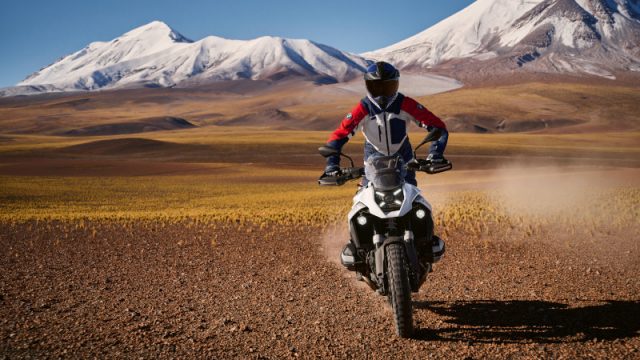BMW Motorrad has finally unveiled the all-new R 1300 GS, its flagship adventure motorcycle. The new bike gets a complete overhaul, from its frame to its engine.
Visually, the newcomer is very different too. BMW has finally ditched the twin headlight design in favour of a single light with matrix technology. It’s surrounded by four LED daytime running lights in the shape of an X. The bodywork is also sleeker, giving the bike a compact and more contemporary look. But let’s start with the engine.
Kilowatts and Newton metres
For power-hungry speed freaks, the new 1 300 cc boxer engine (still air- and liquid-cooled), is the headline act. With a maximum of 107 kW at 7 750 rpm and 149 Nm at 6 500 rpm, it represents a significant power increase over the R 1250 GS, which is capable of 100 kW and 143 Nm.
This motor, with a displacement of exactly 1 300 cc, is the most powerful BMW boxer engine ever, the Bavarian company says. Despite the extra beans, BMW says consumption, at 4.8 litres/100km, is “almost the same” as its predecessor’s. Like the 1250’s engine, the 1300 also uses BMW’s ShiftCam technology and BMW promises that it is more responsive than before.
Power comparison
So, there’s a lot of grunt in the new engine. Here’s a quick comparison from the world of four-wheelers: The Toyota Starlet 1.5 XS delivers 77 kW and 138 Nm, and the Mazda Mazda2 1.5 Active can muster 85 kW and 148 Nm.
I suppose we must consider the output of rival bikes’ engines too. Here they are:
- KTM 1290 Super Adventure R: 118 kW & 138 Nm
- Ducati Multistrada V4 S: 125 kW & 125 Nm
- Triumph Tiger 1200: 110 kW & 130 Nm
Chain vs shaft
Do keep in mind that the KTM and Ducati, using chain drive, can transmit more of their engines’ power to the rear wheel. The shaft-drive systems of the BMW and Triumph suffer more power losses, but they have the advantage of being practically maintenance free.
However, even with these losses taken into account, it’s safe to say the BMW will get more torque to its driven wheel than any of the bikes mentioned above.
While the BMW’s kilowatt output is the lowest, there is no point to their engineers chasing more kilowatts through higher revs, when the engine produces so much low-end torque. At a mere 2 000 rpm, the engine is already making 115 Nm!
So, the new machine offers more power, but another development boosts performance even further.
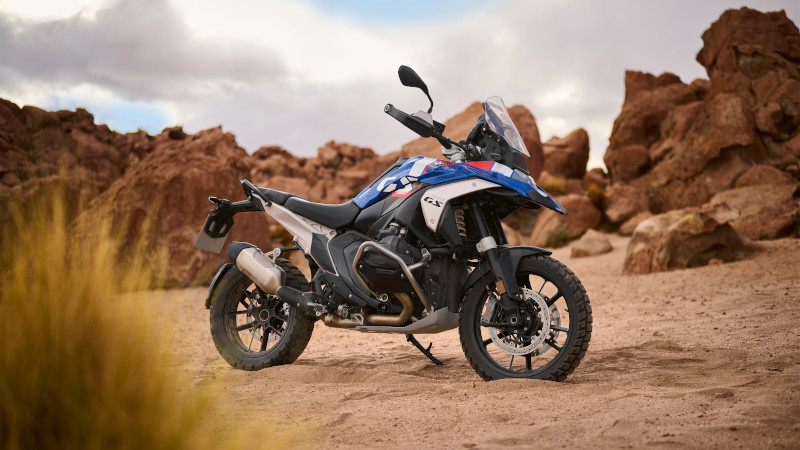
From flab to fab
Over the years, various commentators have lamented the creeping weight in large adventure bikes. Each time a new model comes out, it’s bigger and heavier than its predecessor.
This led to the introduction of lighter, more compact, more affordable models, like the Yamaha T7, KTM 790 Adventure, and Ducati Desert X.
But humans want their bread buttered on both sides. Many riders weren’t ready to accept less power, even when the weight of an elephantine bike (think R 1200/1250 GS) made it difficult or dangerous to ride technical trails.
The Tiger diet
Triumph took on the challenge and achieved impressive weight saving in its 2022 Tiger 1200. Now BMW has pulled off a similar weight-loss trick, making the R 1300 GS 12 kg lighter than the R 1250 GS. Where the 1250’s wet weight was 249 kg, the 1300’s is 237 kg.
Possibly taking another cue from Triumph, BMW also made the 1300 more compact and sleek. This was partly achieved by placing the gearbox underneath the engine, while the 1250’s transmission is behind the engine. This change improved packaging and balance, and reduced overall weight, the manufacturer says.
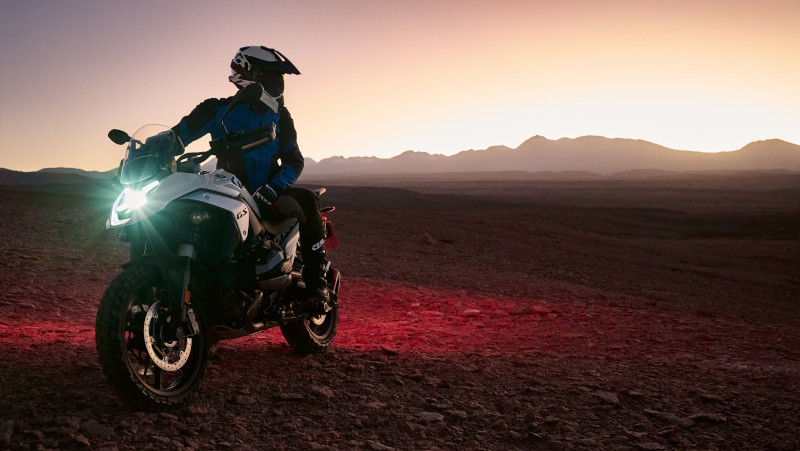
Frame and suspension
BMW also redesigned the skeleton of its big adventure tourer. The main frame, made of steel, is stiffer and more compact than before. The rear frame was also reconceived. In place of the previous tubular steel construction, the new R 1300 GS has a rear frame made of die-cast aluminium. This also increases stiffness, reduces weight, and improves packaging. The short and slim rear end in the new R 1300 GS forms a much stiffer bond with the main frame. This results in a noticeable increase in riding precision and stability, making the bike easier to ride, BMW says.
More lightness added
Adding lightness improves handling, but BMW also gave the new bike “completely redesigned suspension,” it says. Accordingly, there is “even greater steering precision and ride stability thanks to new EVO Telelever with flex element and revised rear wheel guide EVO Paralever.”
These improvements should make for really tidy handling, but those willing to throw even more money at the local Motorrad dealer can order Electronic Dynamic Suspension Adjustment (DSA). This allows “dynamic adjustment of the damping and spring rate, and also load compensation,” BMW says. Without the sports suspension, the new 1300 model adds 20 mm of spring travel at the front and rear, for a total of 190 mm at the front and 200 mm at the rear.
But wait, there’s more. Customers can also add adaptive vehicle height control and sports suspension. Height control can be useful, but it’s hard to guess why anyone would want sports suspension on an adventure bike, unless they will be using it as a tourer only.
Wheels and spray guard
Maybe the big GS’ popularity as a grand tourer explains why the company didn’t copy Triumph in offering a 21” front wheel. The R 1300 GS retains its smaller 19” wheel, which limits its application. Owners who have their sights on long stretches of off-road riding must settle for a pair of knobbly tyres to deal with inclement road surfaces.
A standard feature on all model variants of the new BMW R 1300 GS, is the spray guard on the rear. Due to its double-shell design, it creates an air duct that discharges dirt particles and water. “This amazingly effective function is a result of intensive work in the wind tunnel, where the aerodynamic properties of the new BMW R 1300 GS were refined in detail,” BMW says.
Lights and electronics
The headlight of the R 1250 GS provides riders with excellent nighttime forward vision. With the R 1300 GS, BMW takes lighting a step up by fitting a matrix headlight. This is a crucial safety feature for any vehicle travelling at night.
Matrix lights use a cluster of LEDs to project light dynamically. When another vehicle approaches from ahead, forward light sensors on the GS ‘tell’ the LED system exactly where to cast light without blinding the driver of said vehicle. While that vehicle(s) gets closer, the LEDs constantly make adjustments to project as much light as possible on either sides and in front of the oncoming vehicle, even while it changes its position in relation to the GS. It also works when following other vehicles and makes toggling between dim and bright a thing of the past.
On the topic of important safety tech, BMW has installed Dynamic Cruise Control (DCC) with autonomous brake function on the 1300 GS. The significant words here are “autonomous brake function,” since most of us can do with an extra pair of eyes on the road, as Subaru puts it. Just in case a cow suddenly decides to cross the road while you’re fiddling with the infotainment system.
To make the front indicators more visible, BMW has integrated them into the hand protectors where they face oncoming traffic.
Brake with confidence
The new R 1300 GS comes as standard with twin disc brakes using two newly developed, radially mounted four-piston fixed callipers at the front. At the rear, a single disc brake with two-piston floating calliper takes care of business.
BMW’s Motorrad’s Full Integral ABS Pro activates the front and rear brakes simultaneously when pulling the lever for the front brake. The foot brake lever now likewise actuates the front and rear brakes at the same time.
Full Integral ABS Pro is optimised for on-road and off-road use with an additional set-up that depends on the riding mode. In the ABS Pro settings it is possible to lock the rear wheel via the foot brake lever.
Dynamic Brake Control (DBC), a backup system for BMW Motorrad Fully Integral ABS Pro, increases safety when braking, especially in challenging circumstances, by eliminating unintentional throttle application. By intervening in the engine control, the drive torque is decreased when braking, using the full potential of the rear wheel’s braking system. This reduces the stopping distance and keeps the motorcycle steady.
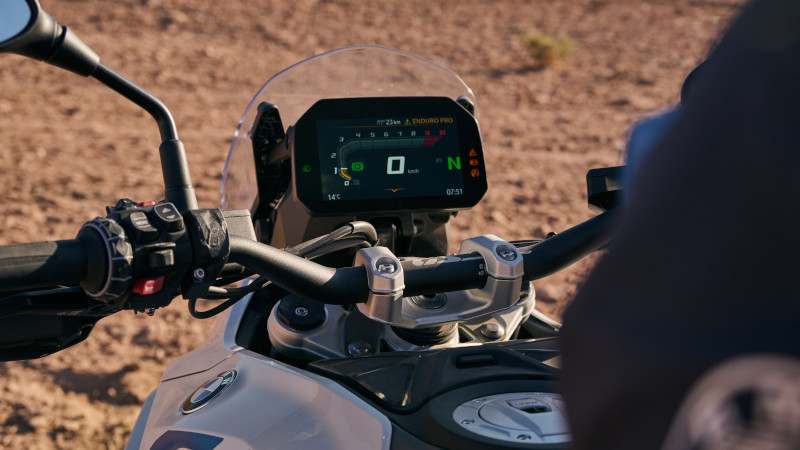
Device charging
The new BMW R 1300 GS provides two separate sockets as standard equipment. The right side of the cockpit has a 12-volt on-board power outlet installed. In addition, a fold-out smartphone charging box behind the handlebars has a USB-A plug with a 5-volt power source. Depending on the model of smartphone, a charging current of up to 2 400 mA is available, allowing for quick charging, According to BMW.
This USB-A socket allows a smartphone to be charged while riding by connecting an adapter cable. BMW Motorrad Accessories offer a kink-resistant USB adapter cable for this purpose.
A GS for every taste
Not too long ago, GS customers could choose between a GS and a GS Adventure, and that was it. With the 2024 R 1300 GS, BMW is offering four versions of the bike, before the Adventure model derivative has even arrived! They are: the R 1300 GS “Pure”, Triple Black, GS Trophy, and Option 719 Tramuntana. Yes, that fourth bike’s name is quite a mouthful. We suggest ordering it like Thai food. Just say “I want 719, please.”
We’ll let BMW Motorrad explain below. (Please note that the manufacturer did not make photos of all model versions available.)
BMW R 1300 GS: pure GS
The basic variant of the new BMW R 1300 GS embodies what the development team has endowed the GS with: compact arrangement of the components and high functionality of the equipment. In “Lightwhite” solid paint and in conjunction with its sharply drawn lines, the new GS has a clean and muscular appearance that embodies the boxer GS theme in style.
The compact and low front end, together with the Sport windshield and wide handlebars, provide an excellent forward view, while the redefined GS ergonomics offer a confident, relaxed riding position. A sporty, slimline passenger seat and functional sports grab handle bridge, emphasises the steeply rising and short rear end. It offers good seating comfort for the passenger, BMW claims. In the basic version, the standard rider’s seat is 850 mm tall. The main frame, cast alloy wheels, and the powertrain are all finished in black.
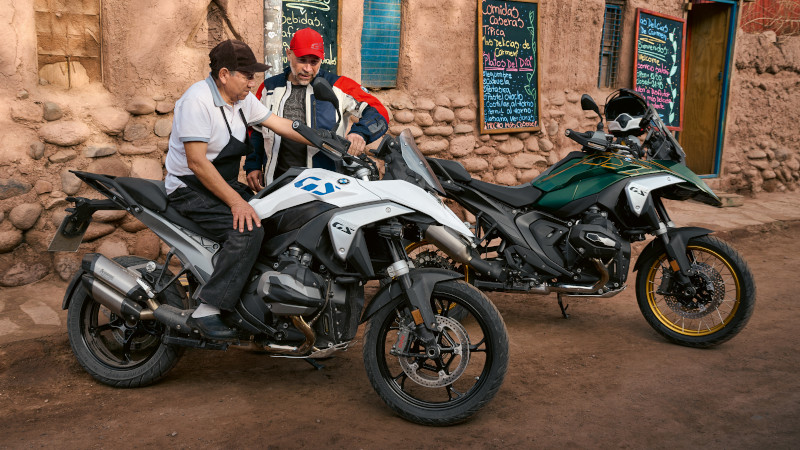
BMW R 1300 GS Triple Black: the masculine machine
The Triple Black has been the most successful model variant of the boxer GS for many years. This colour scheme gives the new BMW R 1300 GS an even more masculine attitude. Light-alloy cast wheels strikingly finished in black solid paint feature an impressively five-spoke design in a V configuration.
The rear frame is likewise finished in black, as are most of the other surfaces. BMW explains: “The aim here is to present the surfaces running from the front of the vehicle to the number plate holder in an interplay of shapes which is muted in terms of colour. The motorcycle’s dynamic performance is powerfully emphasised with a forward-sloping gesture.”
Also finished in black, the luggage carrier included in the Triple Black model variant is integrated in these shapes. In addition, the R 1300 GS Triple Black has Comfort seats, Comfort passenger footrests and a centre stand. The electrically adjustable high windshield also comes with this model variant in combination with the cockpit trim and the wind deflectors.

BMW R 1300 GS Trophy: the off-road expert
The basic finish Racing Blue metallic sets the tone for the model variant GS Trophy. With red and white tapes and inscriptions combined with a rear frame in white metallic matt, the GS Trophy stands for the highest level of performance and sporty off-road use.
The high rider’s seat (870 mm), in combination with the Sport passenger seat, offer the look and ergonomics of a rally seat. In conjunction with the seat cover continued on the fuel tank cover, it forms a unit that can be used along its entire length.
BMW has equipped the GS Trophy with radiator guards for damage protection. The robust cross-spoke wheels also belong to the range of off-road-oriented fittings. They are supplied with black rim rings, but these are also available in gold.
As with all model variants, the flat tank ramp and the steeply rising rear end are crucial for off-road riding: optimum freedom of movement is essential here. The conceptual division of the seat enables the ergonomics to be varied via the integrated seat angle adjustment for the rider’s seat. Instead of the high rider’s seat, the standard (850 mm) and low (830 mm) comfort rider’s seats can alternatively be mounted, independently of the passenger seat.

BMW R 1300 GS Option 719 Tramuntana: the exclusive machine
The new R 1300 GS shows its exclusive and technically sophisticated side in the model variant Option 719 Tramuntana. This combines cross-spoke wheels in gold with black components such as the main and rear frames, powertrain and the luggage carrier with grab handle. BMW says the gold anodised handlebar perfectly matches the gold-coloured lining on the body components and the gold rim bands.
The Option 719 Tramuntana offers elegantly packaged technology by means of a high-quality paint finish. The side trim sections and the front wheel cover at the top are finished in Aurelius Green metallic paint, while the aluminium tank and intake silencer cover are likewise finished in Aurelius Green metallic but with a matt clear coating. The fuel tank centre cover in Luxor black/grey and the cylinder head covers in black metallic matt blend in harmoniously with this, BMW claims.
The optional equipment available ex works for the Option 719 Tramuntana model variant include a top case carrier in matching metallic black and a grey-coloured hand protector extension (included in the Touring Package). Cross-spoke wheels with black rim rings and the titanium-coloured anodised sports brake (included in the Dynamics Package) complete the picture.
Prices
The new R 1300 GS range starts at R258 060. You can use BMW’s configurator to build-a-bear your dream bike, whether you can afford it or not.
[mailchimp_list]


